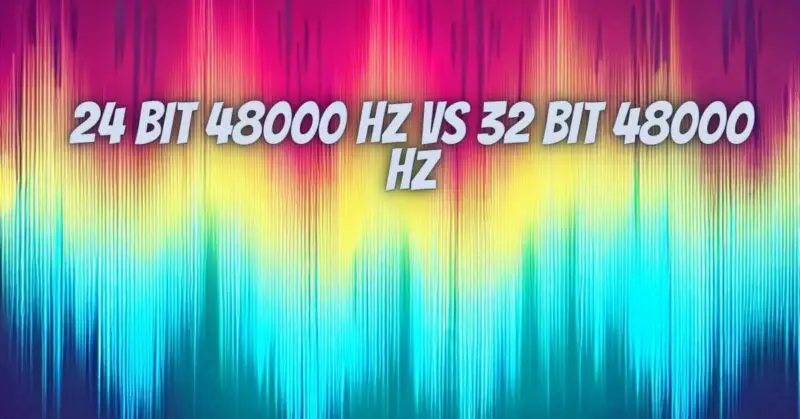In the realm of digital audio, bit depth and sampling rate play pivotal roles in determining the quality and fidelity of recorded and reproduced sound. This article will delve into the world of digital audio depth, comparing two common standards: 24-bit 48kHz and 32-bit 48kHz. We’ll explore the nuances, differences, and practical applications of these formats to help you understand their significance in the world of audio.
Bit Depth and Sampling Rate: A Quick Recap
Before we compare 24-bit 48kHz and 32-bit 48kHz audio, let’s revisit the fundamental concepts:
- Bit Depth: Bit depth refers to the number of bits used to represent the amplitude of a digital audio signal. A higher bit depth allows for greater dynamic range and precision in capturing audio.
- Sampling Rate: Sampling rate, measured in kHz (kilohertz), represents the number of samples (data points) taken per second to record audio. A higher sampling rate can capture more audio detail and higher frequencies.
Now, let’s explore the differences and applications of 24-bit 48kHz and 32-bit 48kHz audio:
24-bit 48kHz: High-Quality Standard
- Bit Depth: 24-bit audio provides 16.7 million possible amplitude values, resulting in a dynamic range of approximately 144 dB. This extended dynamic range captures subtle audio details and nuances, making it suitable for audiophile-grade recordings and professional audio production.
- Sampling Rate: A sampling rate of 48kHz captures audio frequencies up to 24kHz, covering the entire audible range of human hearing. It is a standard for high-quality audio production, ensuring faithful reproduction of sound.
- Dynamic Range: The dynamic range of 24-bit audio is well-suited for capturing and reproducing the full spectrum of sound, from the softest whispers to the loudest crescendos in music and audio.
- Applications: 24-bit 48kHz audio is commonly used in professional audio recording, music production, and high-definition audio playback. It provides precision and fidelity for audiophiles and professionals alike.
32-bit 48kHz: Unparalleled Precision
- Bit Depth: 32-bit audio offers a staggering 4.3 billion possible amplitude values, resulting in an extended dynamic range that exceeds 192 dB. This remarkable precision is rarely necessary for standard audio applications but is valuable in specific scenarios.
- Sampling Rate: Like its 24-bit counterpart, 32-bit 48kHz audio maintains a sampling rate of 48kHz, capturing frequencies up to 24kHz.
- Dynamic Range: The extended dynamic range of 32-bit audio ensures that even the faintest audio signals can be captured without distortion or quantization noise.
- Applications: 32-bit 48kHz audio is primarily used in professional audio recording and mastering, particularly in situations where extreme precision is required, such as in high-resolution audio projects, sound design, or audio restoration.
Choosing Between 24-bit and 32-bit 48kHz
The choice between 24-bit 48kHz and 32-bit 48kHz audio depends on your specific audio needs:
- 24-bit 48kHz: Suitable for high-quality music playback, recording, and production in most scenarios. It offers exceptional audio quality, making it the standard for audiophiles and professional audio production.
- 32-bit 48kHz: Reserved for specialized audio applications that demand the highest precision, particularly in professional audio mastering, sound design, and audio restoration. It provides unparalleled dynamic range and precision but may be overkill for standard music listening.
In summary, both 24-bit and 32-bit 48kHz audio formats offer exceptional sound quality, with 32-bit audio providing unparalleled precision. Your choice should align with your specific audio goals, whether you’re a casual listener, an audiophile, or a professional working on high-fidelity audio projects.


